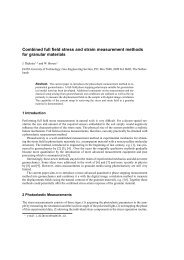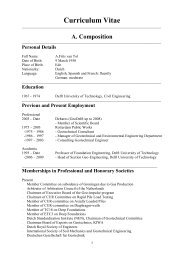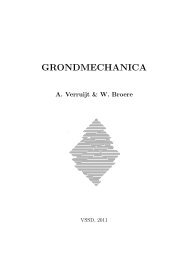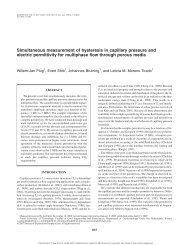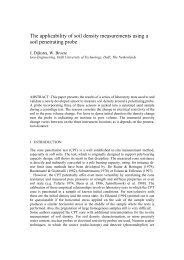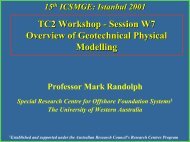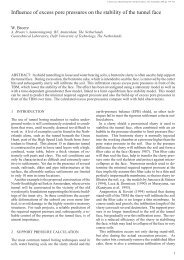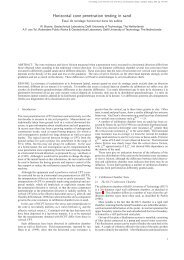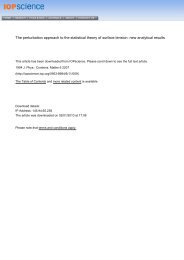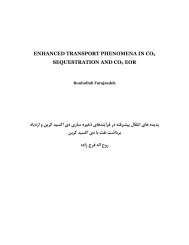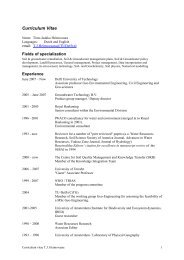Tunnel Face Stability & New CPT Applications - Geo-Engineering
Tunnel Face Stability & New CPT Applications - Geo-Engineering
Tunnel Face Stability & New CPT Applications - Geo-Engineering
Create successful ePaper yourself
Turn your PDF publications into a flip-book with our unique Google optimized e-Paper software.
6 2. <strong>Stability</strong> Analysis of the <strong>Tunnel</strong> <strong>Face</strong>range of allowable support pressure for a given tunnel project will depend among other things onthe actual soil and groundwater conditions, the excavation method and the size and overburdenof the tunnel. To find the minimal and maximal allowable support pressures, a number of modelshas been proposed in literature over the years to describe different possible failure mechanismsof the tunnel face and to calculate the properties of the support medium necessary to preventcollapse.These models can be categorised into three main classes based on the type of failure mechanismthey describe. Models which describe the behaviour of a group of grains or a single grainat the tunnel face are called internal or micro-stability models. Models which describe a failuremode of a large part of the face or the entire face are called external or global stability models.Some authors further subdivide the external models into local stability models, which do notdirectly influence the soil surface, and global stability models, which do. Other authors definelocal instabilities as those external instabilities which influence only part of the tunnel face, regardlessof their influence on the soil surface, and that definition will be used in this thesis. Bothmicro- and local instabilities may well initiate progressive failure and lead to a global collapseof the tunnel face [10]. A third class of models are those which in themselves do not describethe likelihood of occurrence of an instability of the soil around the TBM, but of the loss of thesupport medium, which in turn of course may lead to a reduction of the support pressure andsubsequent collapse of the tunnel face.In the following sections a brief overview of the different models reported in literature will begiven for each of those three categories, as well as a number of field and laboratory observations.A number of effects identified from field cases and laboratory tests is not included in currentstability models. Especially the infiltration of the support medium into the soil in front of theTBM and the presence of excess pore pressures may have a profound effect on the stability of thetunnel face. In section 2.2 a stability model will be constructed that does include those effectsand the results obtained with this model will be compared with field observations in section 2.4.In section 2.3 the sensitivity of the model to the input parameters is investigated as well as theinfluence this sensitivity has on the determination of safety factors. Overall conclusions aboutthe use of face stability models and the newly developed model in particular will be presentedin section 2.6.2.1.1 Micro-<strong>Stability</strong>Micro-stability, the stability of the single grain or a small group of grains at the tunnel face, ismainly a problem in soils with no or low cohesion and a slurry or air supported tunnel face. Insuch conditions grains may fall from the soil matrix under gravitational forces. When followedby subsequent grains the face may erode and this can introduce a local or global collapse. Toprevent this type of collapse, a minimal pressure difference over the grains is necessary. Thishas no direct influence on the support pressure, but on the pressure gradient into the soil. Aswill be shown, this leads to a minimal shear strength requirement for the slurry.According to Müller-Kirchenbauer [123] a small cohesionless soil element at the tunnel faceis subjected to gravity and acted upon by forces from the support medium, s F = i 0 γ F , and thesurrounding soil (see figure 2.2). For a given slope α, failure occurs wheni 0γ Fγ ′ sin ϕ = sin(α − ϕ), (2.1)with i 0 the stagnation gradient, γ F the unit weight of the suspension, γ ′ the effective unit weight



